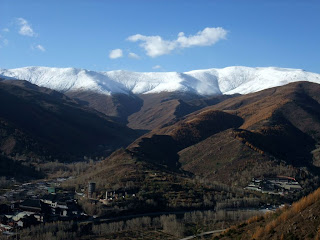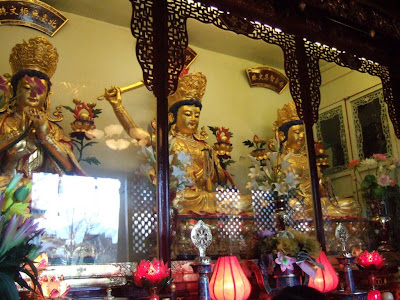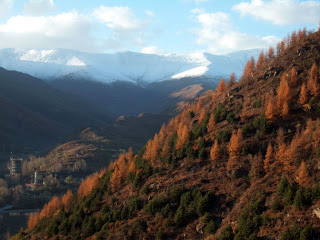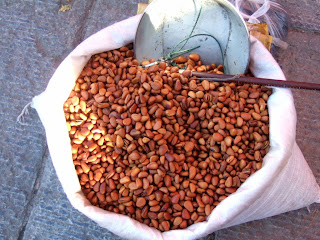
Temple Dailuo-Ding (黛螺顶) situated at the east side of Taihuai-zhen (台怀镇) town center was first established in Ming Dynasty (1465-1487). It was built on a small hill top at the mid way of a lofty mountain shaped like a huge shell, which is actually a small ridge extended from the East Peak. Though the elevation is only 400 meter but when standing at Qingshui-He (清水河) river side and look up, the temple at the hill top was like hundreds of storey high-rise building. The Arch Gates of the temple were most of the time amidst in the mist and in summer, wide areas were covered with green grasses. It was first called Daluo-ding (大螺顶) or Green Peak (青峰) and Buddha Top Nunnery (佛顶庵) was the name given to the ancient temple at the peak.. Starting from year 1786, the name Dailuo-ding was finalized to apply. There are three ways to go up Dailuo-Ding. The old route is from northern tip of the mountain walking along with the ridge and the shorter route is to follow the 1080 steps from Southern tip. The latest and easiest way of course is to take a cable car that had begun service in August 1995 but it was not always in service as Wutaishan's weather is unpredictable and is very windy sometimes.


There was a legend about Dailuo-Ding. It was said that Emperor Qianlong (1711-1799) came to Wutaishan several times but each time due to bad weather, he could not ascend up to the five peaks to pay homage to Bodhisattva Manjushri. In Februay 1781, he visited Wutaishan and once again he did not have the chance to go up the peaks. He called upon The Abbot of Dailou-ding Rev Qingyun and questioned him why. The Abbot honestly told him that weather of Wutaishan was 8 out of 12 months snowing or wind storming. The best time to climb the 5 peaks only was in June or perhaps in May, July or August, other than that, it was not suitable to ascend the peaks. Being an Emperor Qianlong was not too comfortable with this answer. He ordered an assignment to Rev. Qingyun that when he came to Dailuo-Ding five years later, he wanted to worship Bodhisattva Manjushri of 5 directions but not ascending the 5 peaks. Rev. Qingyun could not have any idea of how to fulfill this difficult task. 2-3 years later, a Sami in the temple finally thought of a method to solve his problem. He suggested to imitate and sculpt the images of the five Manjushri at the five peaks and enshrine them in the Main Shrine Hall so that the Emperor could worship the five Bodhisattva without ascending the five individual peaks. The Hall was later named as Hall of Manjushri in Five Directions. When Emperor Qianlong came in year 1786 March for his 5th visit to Wutaishan, he proceed to Dailuo-Ding and entered the Hall to pay respect to the five images of Bodhisattva Manjushri, which was his wish that longed for years. He was overwhelmed that he immediately wrote down a famous poem about Dailuo-Ding, which was engraved at the over surface of a stone stele presently displayed at the stair way of the Buddha's Hall. The engraved poem of Emperor Qianlong written as like below 乾隆帝的亲笔题诗《黛螺顶》: 恋回谷抱自重重,螺顶左邻据别峰。云栈屈盘历霄汉,花宫独涌现芙蓉。窗前东海初升日,阶下千年不老松。供养五台曼殊像,者黎疑未识真宗。


The 1080 green stone built steps ascending to Dailou-Ding was named as The Route of Great Wisdom (大智路) followed the name of Great Wisdom Bodhisattva Manjushri. The construction of this route was supported by Shanxi State Government with a half million (rmb) contribution from The Abbot Rev. Kai-Zheng (开证法师) of Temple Hongfa-si of Taiwan (台湾高雄宏法寺) and it was completed in year 1991. The whole length measured 108 meter long by 2.2 meter wide with 1080 steps. The number of 1080 represents 108 numbers of 10 realms. Though this could be the shortest distance to Dailou-ring, it is the toughest as the stone steps are very steep. It was said that whoever go through The Great Wisdom Route, would get rid off all misfortunes and annoyances, would increase wisdom and most important of all, would be safe through out the life.



The breath-taking scenery viewed from Dailuo-ding.

















Arriving Temple Shancai-Dong (善财洞) short time after going up from the southern tip via the 1080 route of great wisdom. There are upper and lower courts in Temple Shancai-Dong. The upper court was built during the reign of Qing Emperor Qianlong (1735-1796) and lower court was built in Emperor Jiaqing period (1796-1820). It was so named as there was a Tang made brass image of Sudhana (善财童子) unearthed together with images of Manjushri and Maitriya from a nearby cave. And it was said that this was the cave where Emperor Kangxi (1662-1722)found a poem written by his father Emperor Xunzhi who secretly left home to become a monk in Wutaishan. The main hall built near the cave now enshrined an image of Shadhana.


Magnificent view of Wutaishan










It's quite tough to complete these 1080 steep steps of The Great Wisdom Route....Short of breath but need to go on....in order to sweep off human's 108 misfortunes and annoyances....to be safe forever!



Meeting many devoted Buddhists along the 1080 steps Great Wisdom Route. They sincerely bowed with forehead, hands and knees down to the ground each time he walked three steps.


The majestic mountain ranges of Northern Terrace.











Under the feet of Dailuo-Ding hill top is Taihuai-Zhen.




Dailuo-Ding was within our eye sight! It took us two hours to successfully completed the 1080 steep steps. You also can make it if, and when you have a will!


We finally arrived at The Wooden arch gate and The Entrance Gate of Dailuo-Ding. We met the pair of its sculpted stone lions and of course also greet with its fresh and chill air.


Looking at the three large Chinese character of Dailu-Ding (大螺顶) hanging under the eave of its Wooden Arch Gate, we were overwhelmed with joys. There was a beautiful view watching pavilion at the southwest corner after crossing over The Arch Gate. Temple Dailuo-Ding covering a land area of about 3000 sq meter, has only 48 building structures within its site. Main halls in line with central axis that face west include Lokapala Hall (天皇殿), Zhantan Hall (旃檀殿), Main Shrine Hall and the Hall for Bodhisattva Manjushri of 5 directions (五方文殊殿).



The Lokapala Hall that enshrines with four Heavenly Kings is also the Entrance Gate of Temple. Drum and Bell Towers are by its two corners. The two ancient stele recorded with matters relating to the restoration and construction of images, were erected behind the entrance gate. One was dated back to year 1592 during the reign of Emperor Wanli of Ming Dynasty and the other Stele was made during the reign of Emperor Kangxi (1662-1722) in Qing Dynasty.



The Zhantan Hall at second court has six pointed roof eaves on top and sits on a hexagon foundation base of 10 meters in length. The Hall enshrines a standing image of Buddha Sakyamuni which was quite rare in Buddhist Temples. The Hall was also called Buddha Standing Hall but as the original image was sculpted from the hard red sandal wood, so it was more often known as Zhantan hall. According to Buddhist Legend, When Buddha was going to ascend to Trayastrimsa heaven to lecture the Abhidhamma Sutra to his mother after his enlightenment, his disciples in order to keep his image in the human realm forever, requested Buddha to stand by the river side and drew a painting of him. People dare not directly look at Buddha as he was such venerable and highly respected so they imitated the image of Buddha basing on his shadow that reflected in the river. The drawn out painting of Buddha was with stripes of water waves and when people followed this painting and sculpted the Buddha Image, it was called Imitated Buddha. The first Imitated Buddha was sculpted from red sandal hard wood so people named it as Red Sandal Buddha. And later in regardless of material used, the image would be named as Red Sandal Buddha as long as the sculpture followed such appearance.


With a width of 16.5 meter and a depth of 11 meter, the hall at the third court houses five images of Bodhisattva Manjushri from the five terraces of Wutaishan. The statues were made from clay with 1.5 meter in height. It is a must for many people who visited Wutaishan to pay worship to Bodhisattva Manjushri of five directions that stationed at the five peaks. But not many people could make it firstly due to its weather and secondly due to the tough journey. Those who are unable to climb to the five terraces to do a big pilgrimage, now may come to this hall at Dailuo-ding to do a small pilgrimage and pay homage to Manjushri of five directions. Emperor Qianlong had made a meritorious deed helping many to easily fulfill their pilgrimage wishes.



Lined from southern end to northern end of the Altar are images of Clever Manjushri (聪明文殊)of East Terrace, Stainless Manjushri (无垢文殊)of North Terrace, Virgin Manjushri (孺童文殊) of Central Terrace, Wisdom Manjushri (智慧文殊) of South Terrace and Lion Roaring Manjushri (狮子吼文殊) of West Terrace.



The two old pine trees with 9 feet in circumference at the court between Five Manjushri Hall and Main Shrine Hall were the never aging pines described in the poem of Qing Long. The Main Shrine Hall enshrines images of Sakyamuni Buddha, Amitaba Buddha, Medicine Buddha with Ananda and Mahakasyapa. Colored sculptures of 18 Arahat are at the two walls in the hall.



The way-place is not only for Mahayanist but also for Tibetans. It attracts groups of lay Buddhists, devotees as well as Bhiksu and bhiksuni to come for pilgrimage.




It was such a blessing that a nun at Dailuo-Ding from Hongkong spoke to us in Cantonese and showed us this old scenic route to go back to Taihuai-zhen. We bought a bag of roasted pine nut from here and found that they were husks only.



The slope of ancient path way is not as steep as the 1080 steps but the distance is much longer. We enjoyed going this way because the sights along the route are splendor.



Bodhisattva Manjushri is incredible. Upon my arrival at Wutaishan, I said to myself I must complete the 1080 steps to Dailuo-Ding and pay homage to the five Manjushri of five directions. But when I saw the height of the hill and its steep steps, I hesitated and turned to Cable car station. It was such a miracle that when we arrived there, the service of cable car terminated. Immediately I knew it was the mean of Bodhisattva manjushri. He wanted me to climb the 1080 steps so that I could get rid off misfortunes and be safe all the times. He knows I can make it. When we finished worship and on the way back to town, cable car started to service again.


The old stone made route was actually the horse tracks of the past and actually there are still horses going this way.


Thank you Bodhisattva Manjushri to insist me climbing up to Dailuo-Ding so that we did not miss such a wonderful sight of Wutaishan.


Beautiful mountain view and the town at distance.



The temple site along the old route coming down from Dailuo-Ding.



The tinted sight of the mountain ranges and ridges. Awesome!



Most of the temple site at Wutaishan were either built against mountain ranges, in the valley, at the mid way or on top of the hill.


The sunset beams had formed a golden back drop behind Temple Jinjie-si. Its fabulous.


There is a temple at the hill top.


Arriving Taihuai-zhen town center in dusk



No comments:
Post a Comment